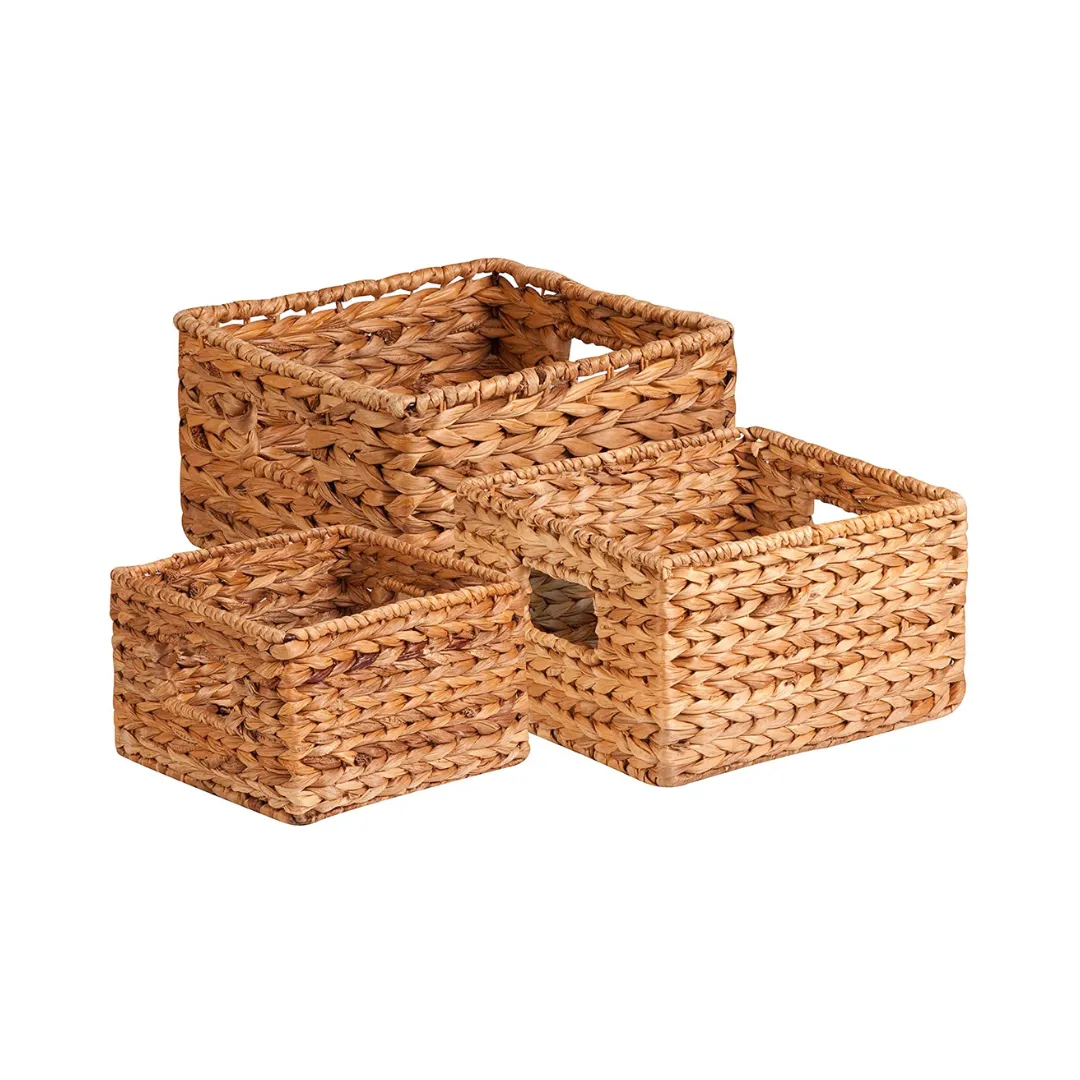We may be compensated if you purchase through links on our website. Our team is committed to delivering honest, objective, and independent reviews on home products and services.
Pantries are a great way to add storage space to your home, whether you want to build a full walk-in pantry or slot in something to an existing space, like putting open pantry shelving along the basement stairs. In this guide, we’ll give you tips for designing your pantry and keeping it organized.
Take Stock of What You Store in Your Pantry
Figure out what you want to stash—or plug in—whether it’s a blender, cookbooks, a folding ladder, or fondue forks you unearth once a year. Don’t wait until the shelves and niches are in—plan for your inventory and any outlets first. Common pantry items include the following:
- Groceries
- Pet food
- Extra cookware
- Countertop appliances
- Large items like a step stool
Pantry Placement
The ideal spot for a pantry is cool, dry, and convenient. A down-to-the-studs renovation offers the most options but it is not the only way to go. There are several ways to find the right placement for your pantry and make it fit.
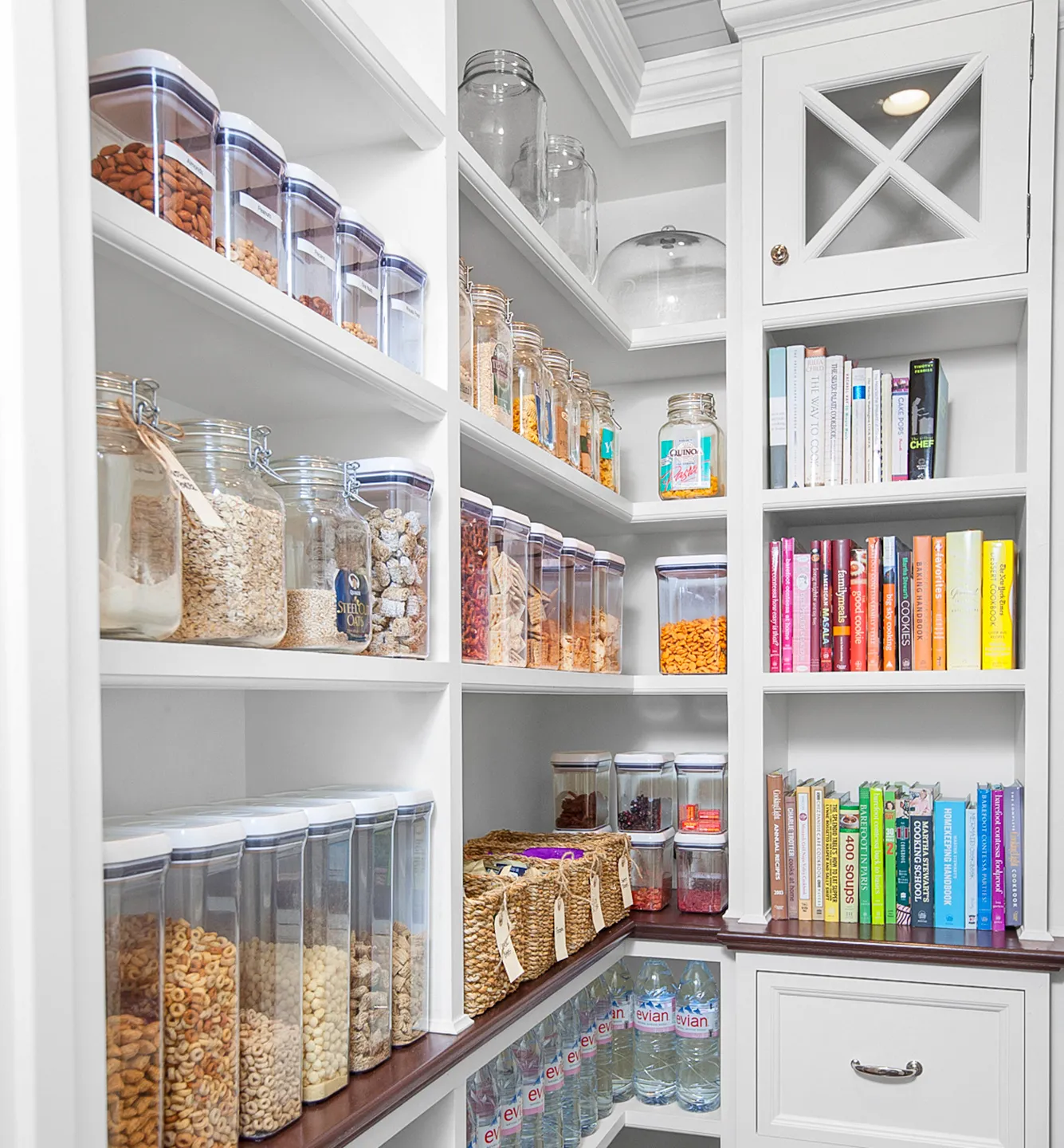
Annex Space
Instead of taking down an interior wall to open up the kitchen to the dining room, consider moving that wall to create space for a pantry on the kitchen side.
Tap a Recess
Pantry shelves can be added to a wall near a prep space or between studs.
Repurpose a Closet
If you aren’t getting a lot of use out of a coat or broom closet, picture it as a pantry.
Bump Out
Colonial pantries were often unheated shed-like lean-tos. Today’s equivalent is a one-story rear addition that could include a half bath or mudroom.
Repurpose the Basement or Cellar
If you have a cool, dry basement or cellar, pop in a freestanding pantry shelf.
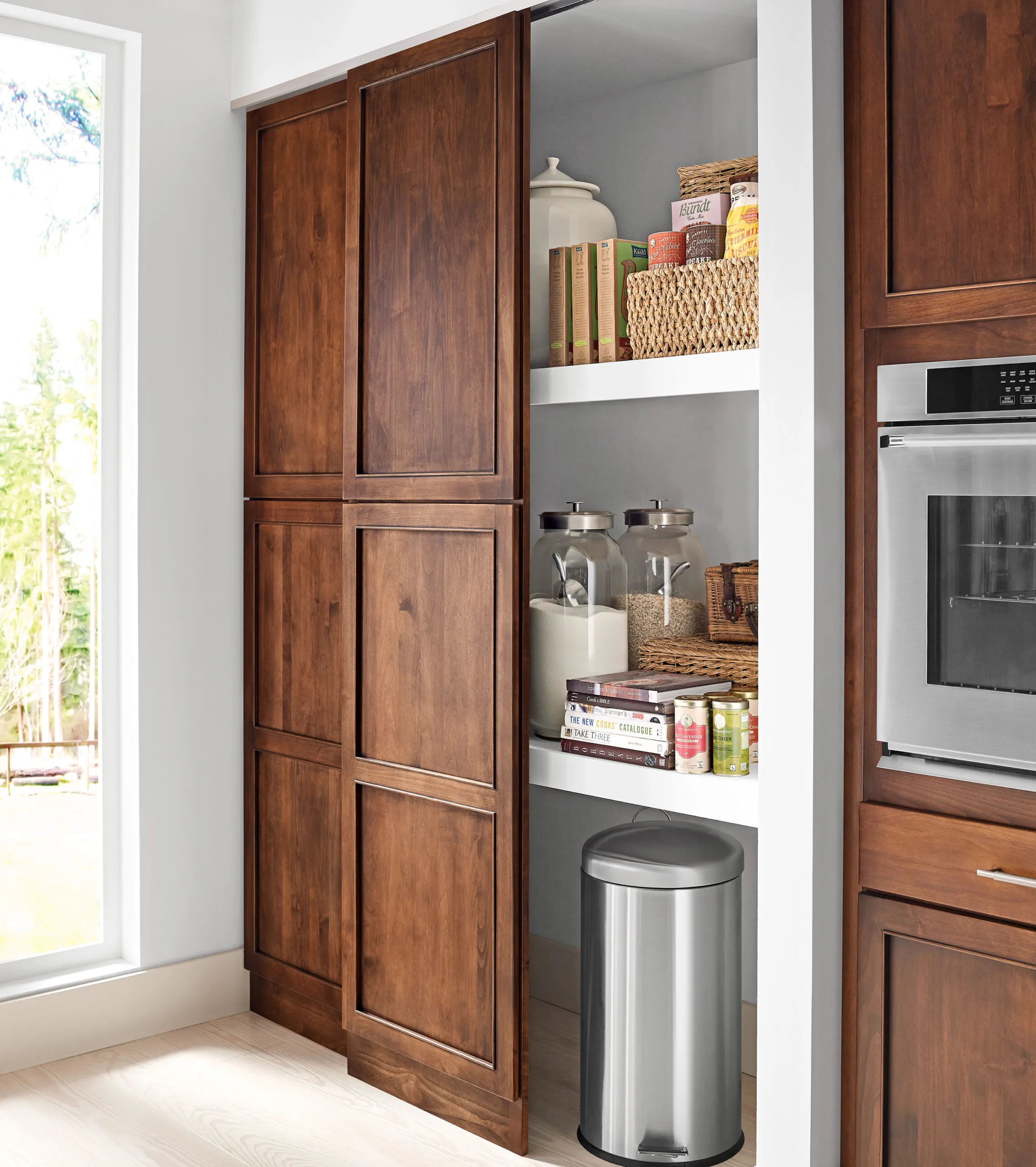
Decide How Big Your Pantry Should Be
Of course, the size of your pantry depends on the footprint you have available in your home. These tips can help you figure out the right sizing for your pantry, and how to maximize your space.
- Accommodate oversized items by leaving ample room between the floor and the bottom-most shelf.
- Measure and allocate space to meet your needs—extra head space for tall canisters, for example. Create cubbies, maybe one for trays and platters, another for a coffee station or bakeware.
- Maximize floor space by installing a sliding or pocket door. Keep in mind that doors can be heavy and require maneuvering to get full access. Doors that swing out ease access—just make sure they don’t block traffic if left open. You can always skip the doors, of course, but they can conceal things nicely.
Tip: Doors that slide or fold are prone to wobbling and sticking, so don’t skimp on the track hardware.
Have your heart set on a pocket door? Watch this video to learn how to install one:
Organize Your Space with Kitchen Pantry Shelving
The key to an organized pantry is a good sense of order.
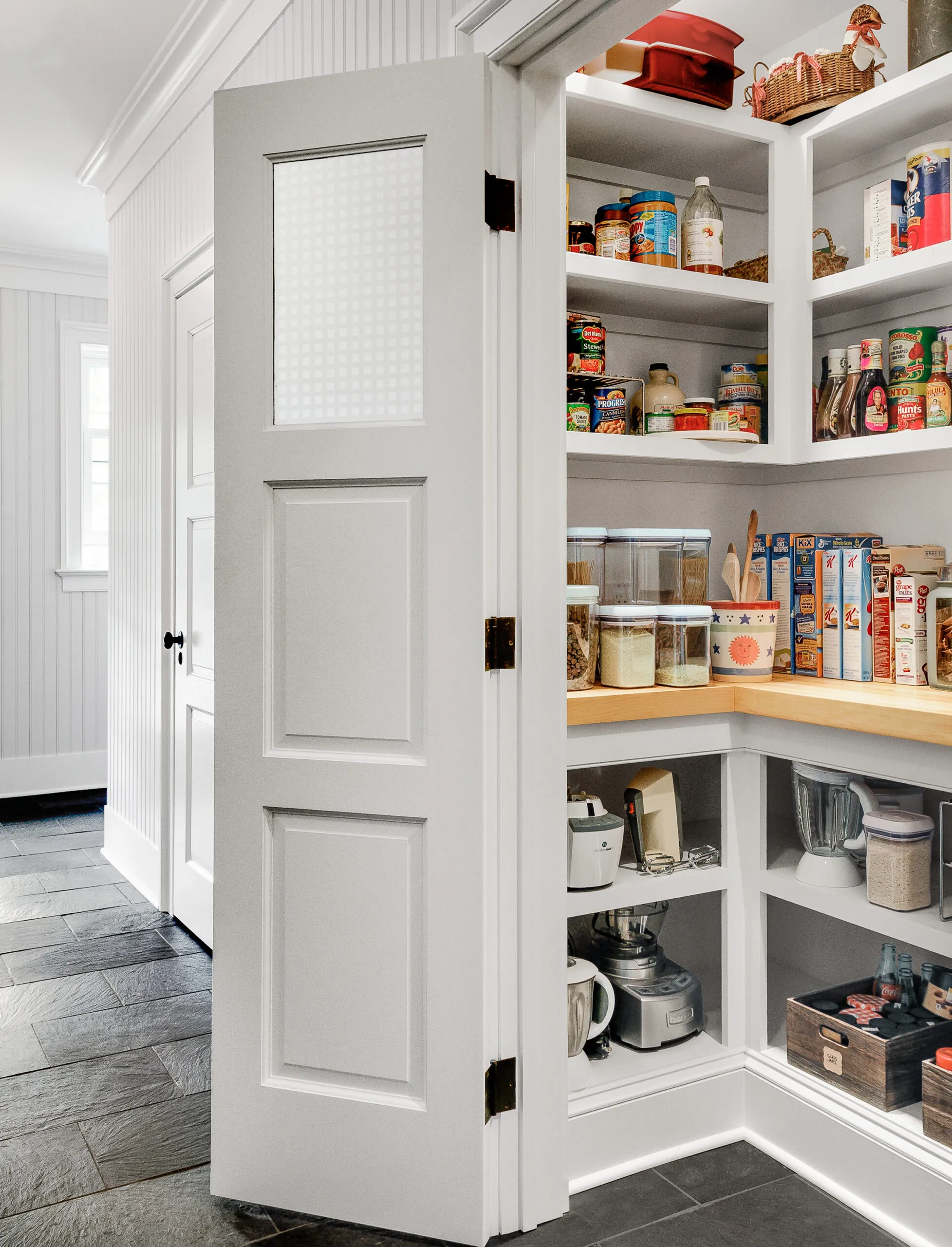
Shelving Options
Sturdy, open wire shelves can hold just about anything and are easy to access. You can also hang boxed open shelves along the stairs and treat the steps as a built-in ladder. If you want a more integrated solution, consider adding custom built-in shelving.
You can add wire shelving to your pantry in various sizes, such as 8 x 8, 12 x 12, and 18 x 18, depending on how much extra storage you’re looking for.
You can also add shelving accessories such as wood grain or polyvinyl chloride (PVC) shelf liners that help prevent smaller items from falling between the wire rungs. Consider a divider for wire shelves that makes it easier to organize pantry items, or security S-hooks, which can connect two shelves.
Common Shelving Dimensions
Typically about 5-by-5 feet, walk-ins can be lined with U-shaped open shelves or cabinets and finished with or without a countertop.
Adjustable shelves offer flexibility. Start with bottom shelves 16–18 inches deep and spaced about 18–24 inches apart for bulky items. Make shelves at eye level 12–14 inches deep and spaced 14–16 inches apart to fit cereal boxes and canisters. Shelves for spices and cans may need no more than 6 inches front to back. When planning for any item, add 2 inches of vertical space so you can tip or slide it in and out easily.
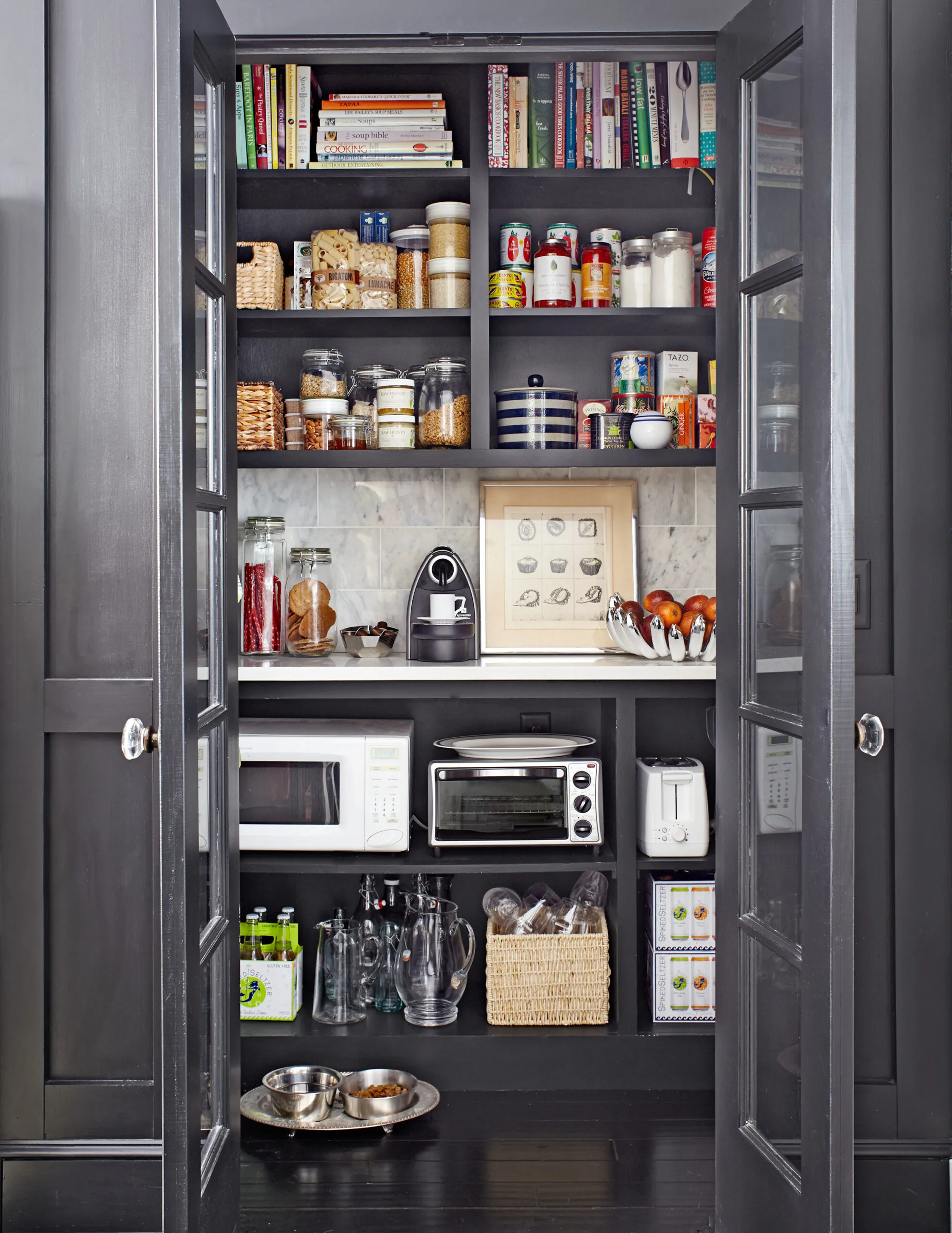
Tips for Selecting Pantry Shelves
- Plywood is the go-to material for shelves—edges can be finished with iron-on veneer banding or wood trim—but other materials can work, too (if you’re careful; see below).
- Avoid door jams by paying careful attention to where doors swing and budgeting enough room for full clearance. If you’re cramped on lateral space, consider omitting doors altogether.
- Light it up with a ceiling fixture or rechargeable puck lights with motion sensors.
- Avoid hide-and-seek by storing smaller items on pantry organizers like lazy Susans and tiered shelf inserts.
- Keep it cool and dry, ideally below 70 degrees Fahrenheit and 45% humidity.
- No AC? Plug in a small dehumidifier.
- No outlet? Try a moisture absorber like those made by Arm & Hammer.
Tip: Think about adding outlets behind shelved small appliances, including a microwave.
Wall-To-Wall Pantry Ideas
If you’ve got the space for a wall-to-wall pantry, let our visual guide inspire you.
Wall-To-Wall Pantry with Sliding Barn Doors
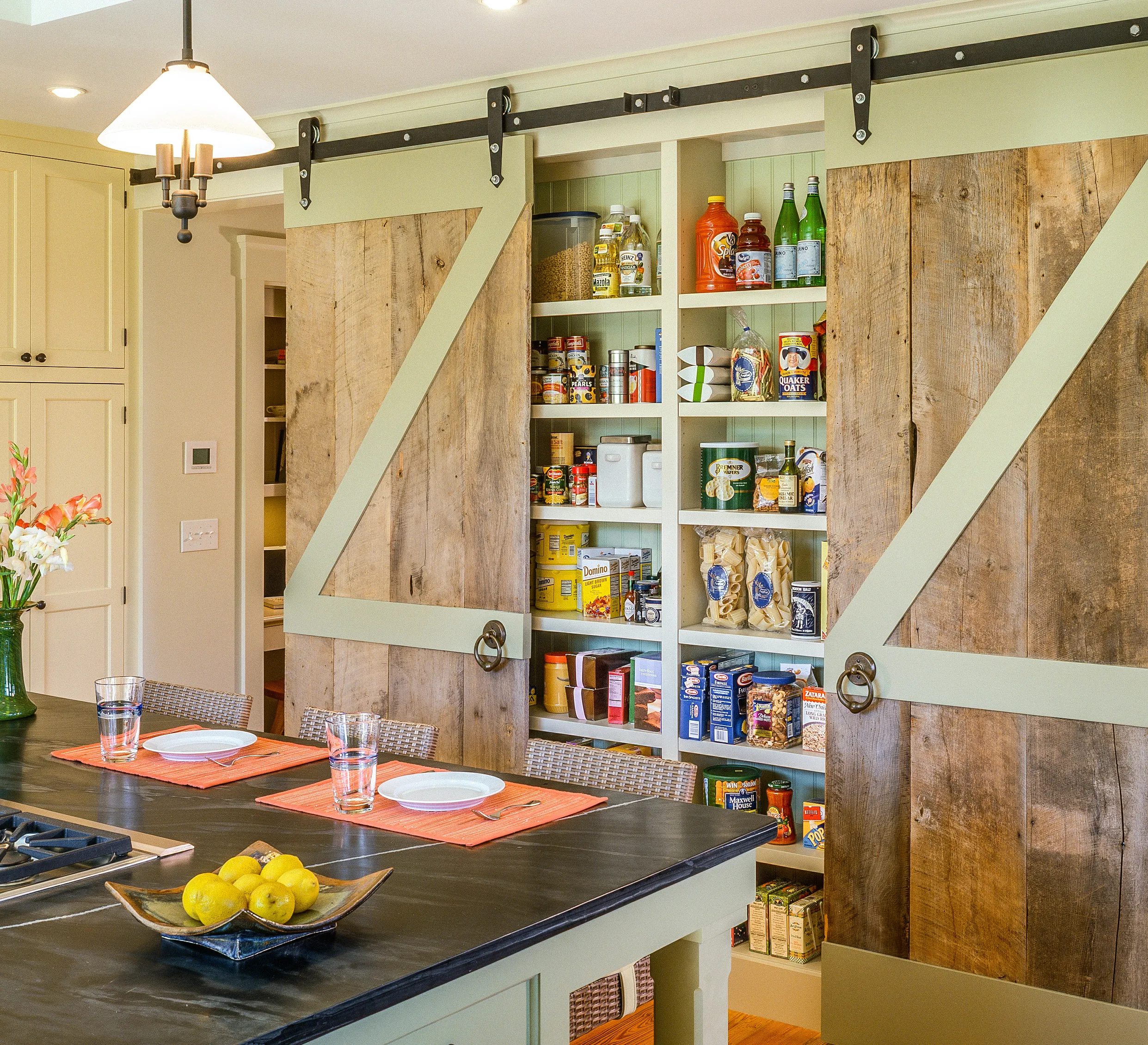
If you have a windowless wall in the kitchen or a nearby hall or mudroom, consider building in shelves with or without doors. Open shelves offer the convenience of being able to quickly grab what you need, but they can also be a magnet for clutter and dust.
Wall-To-Wall Pantry with Open Shelves
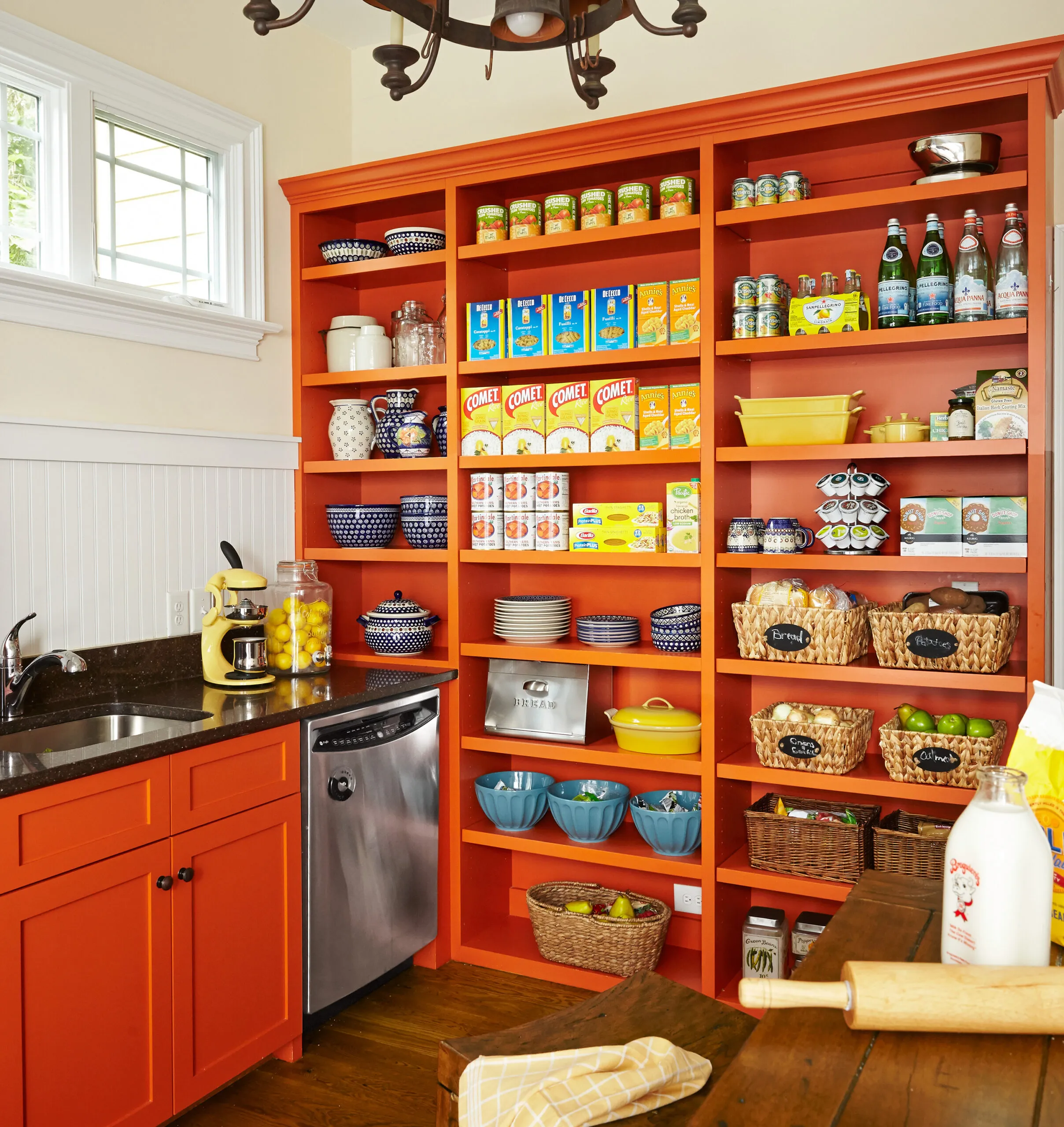
Open shelves typically have a uniform depth. Pro organizers like shelves no deeper than 14 inches to keep everything front and center.
Use baskets and ceramics, as shown above, to create an attractive shelfscape.
Pantry Cabinet Ideas
To answer the call for pantry-style storage, cabinetmakers now offer options that blend in with the rest of the kitchen storage, from simple upgrades like a tall pullout to full-blown built-ins with a hutch-like appeal.
Tip: Before lining cabinet doors with extra shelves, make sure there’s room inside for the doors to close.
Batwing Cabinets
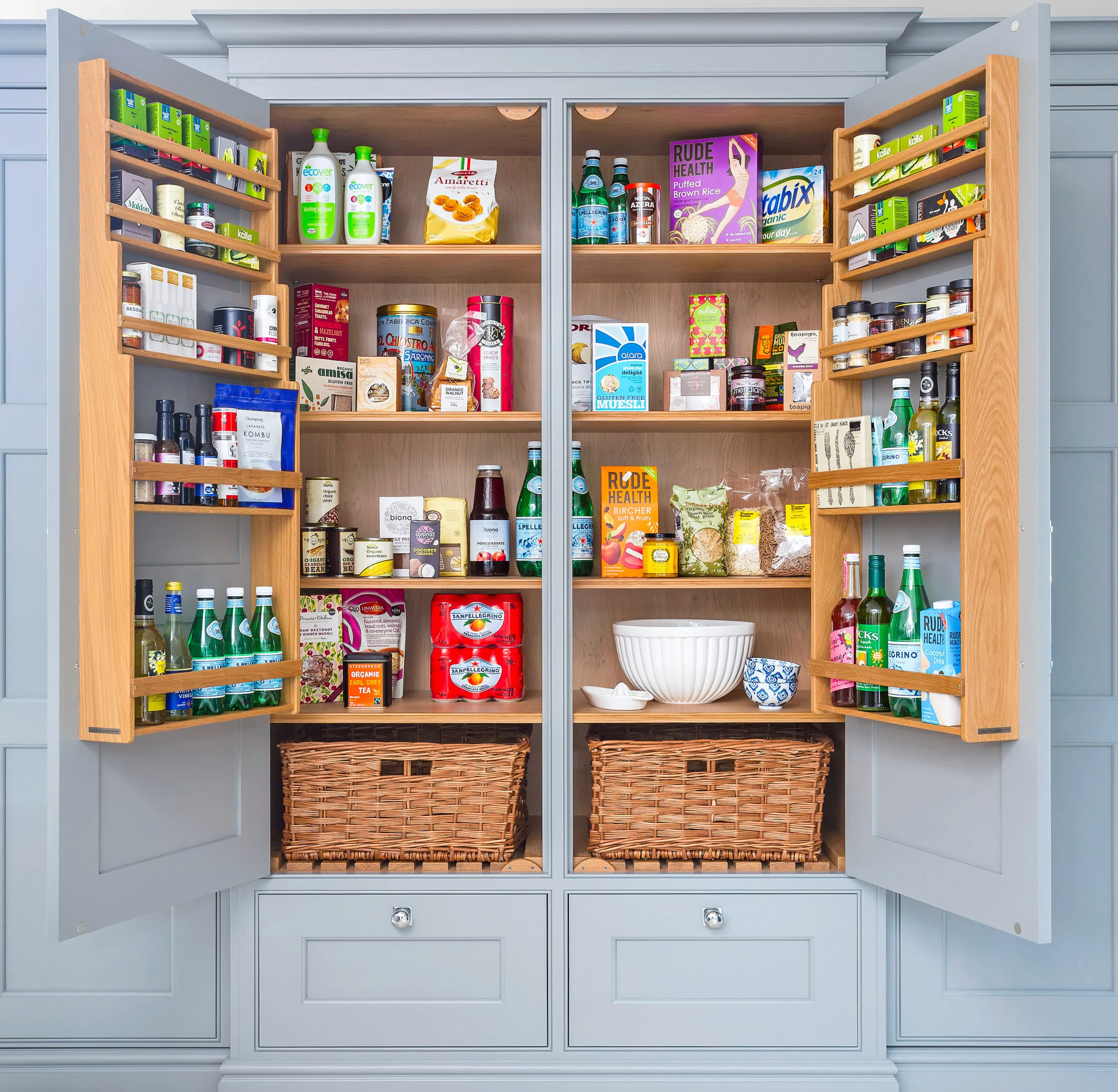
“Batwing” pantry cabinets mirror French-door refrigerators, with restricted door swings and bottom-mount drawers. Custom models, like the one shown above, allow quick access to essentials, while drawers hide other items.
Cabinet Pull-Out Shelves
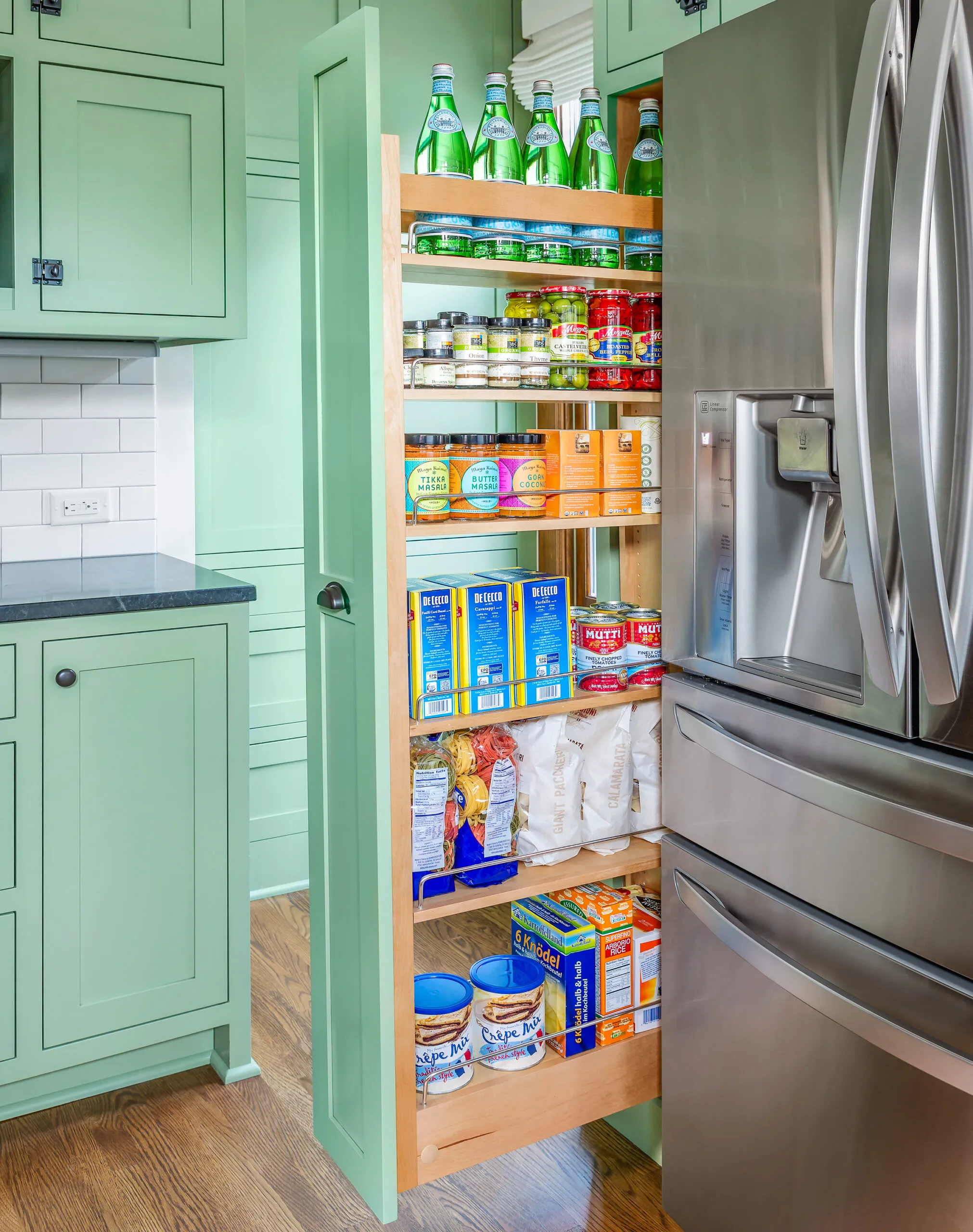
Narrow slide-outs are open on both sides and make use of awkward space.
Rev-A-Shelf makes a retrofit pull-out cabinet organizer that’s just 3 inches wide.
Tip: Heavy-duty drawer slides are a must for slide-out pantries. They should operate smoothly under a weighty load.
Cabinet upgrades include wooden rollout trays that come in different widths and depths and can be installed at varying heights, depending on what you want to store.
Repurposed Pantry Ideas
Older houses may not have surplus closets and rooms, but they do have nooks and crannies that can be converted into pantries or populated with freestanding furniture.
Under-The-Stairs Pantry
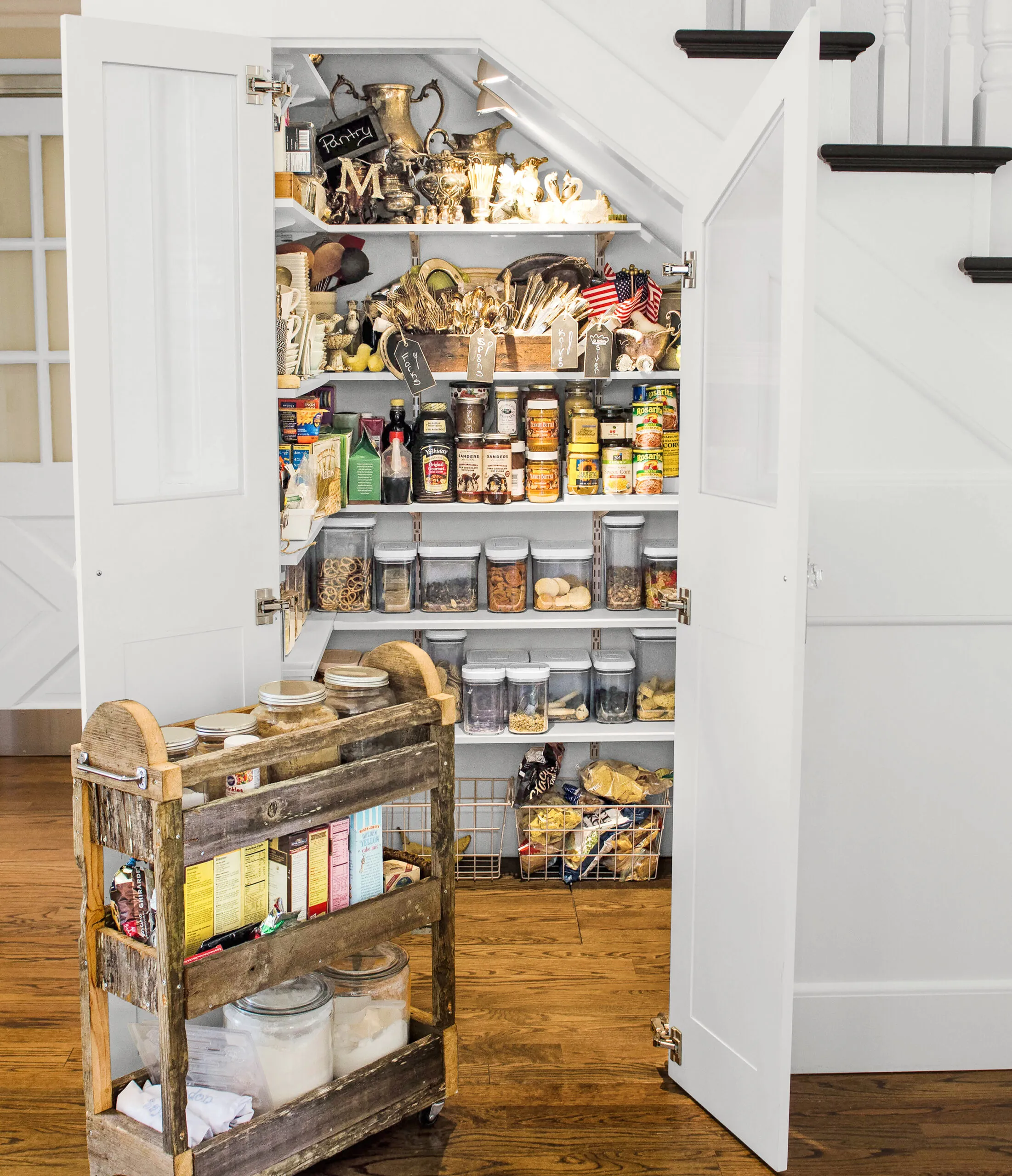
Tucked under the stairs, this hideaway makes creative use of former dead space, complete with push-latch doors that blend with the paneled wall, shallow built-in shelves, lighting, and a baking cart that rolls right into the kitchen.
Freestanding Kitchen Pantry Cabinet
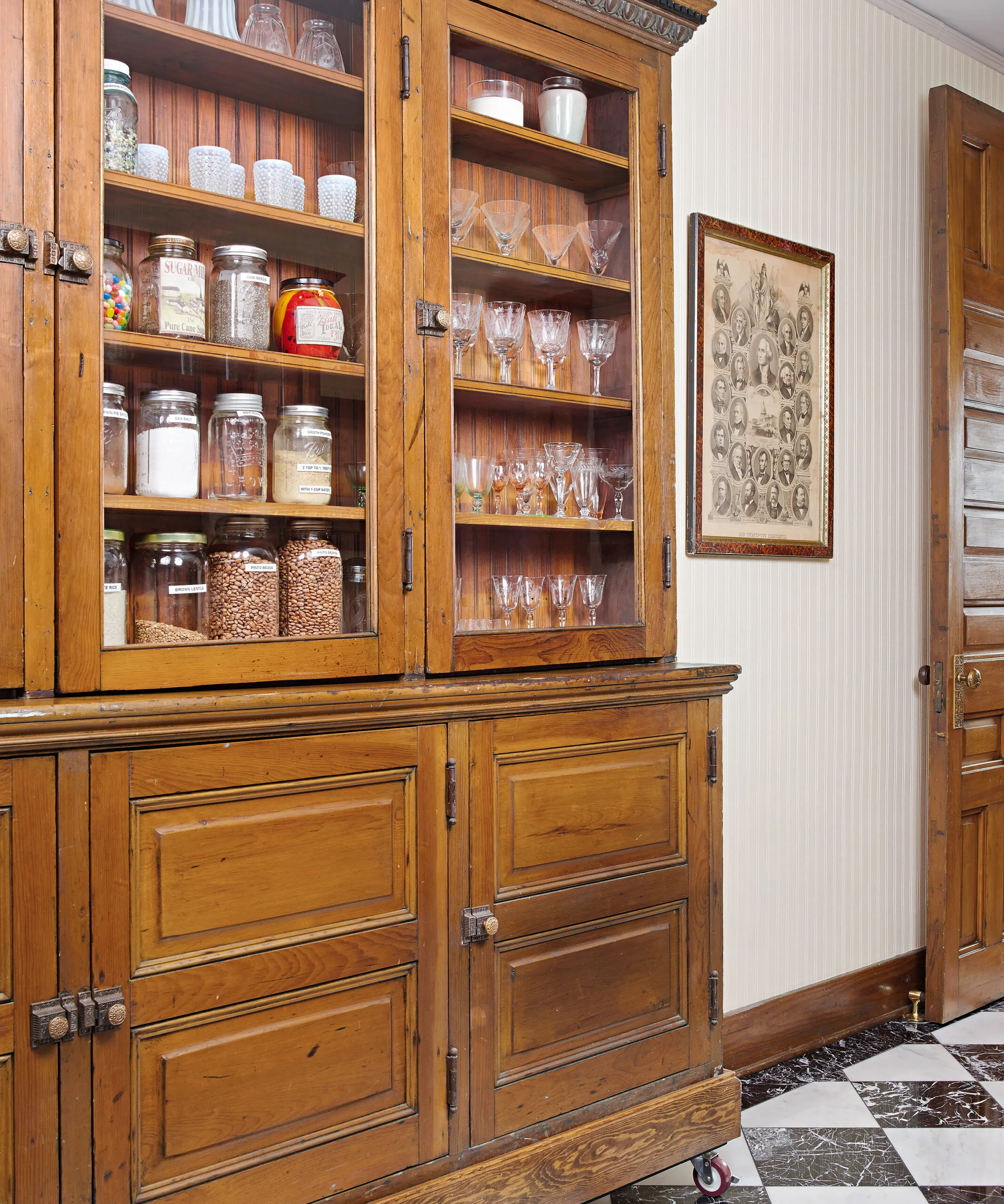
Freestanding storage like this unpainted vintage hutch can add warmth as well as function. Look for strong shelves that keep everyday items easy to see and reach.
Ways to Spice Up Your Pantry
Your pantry can be a hardworking space—but that doesn’t mean it can’t have style. Below are three colorful upgrades to consider.
Round Sharp Corners
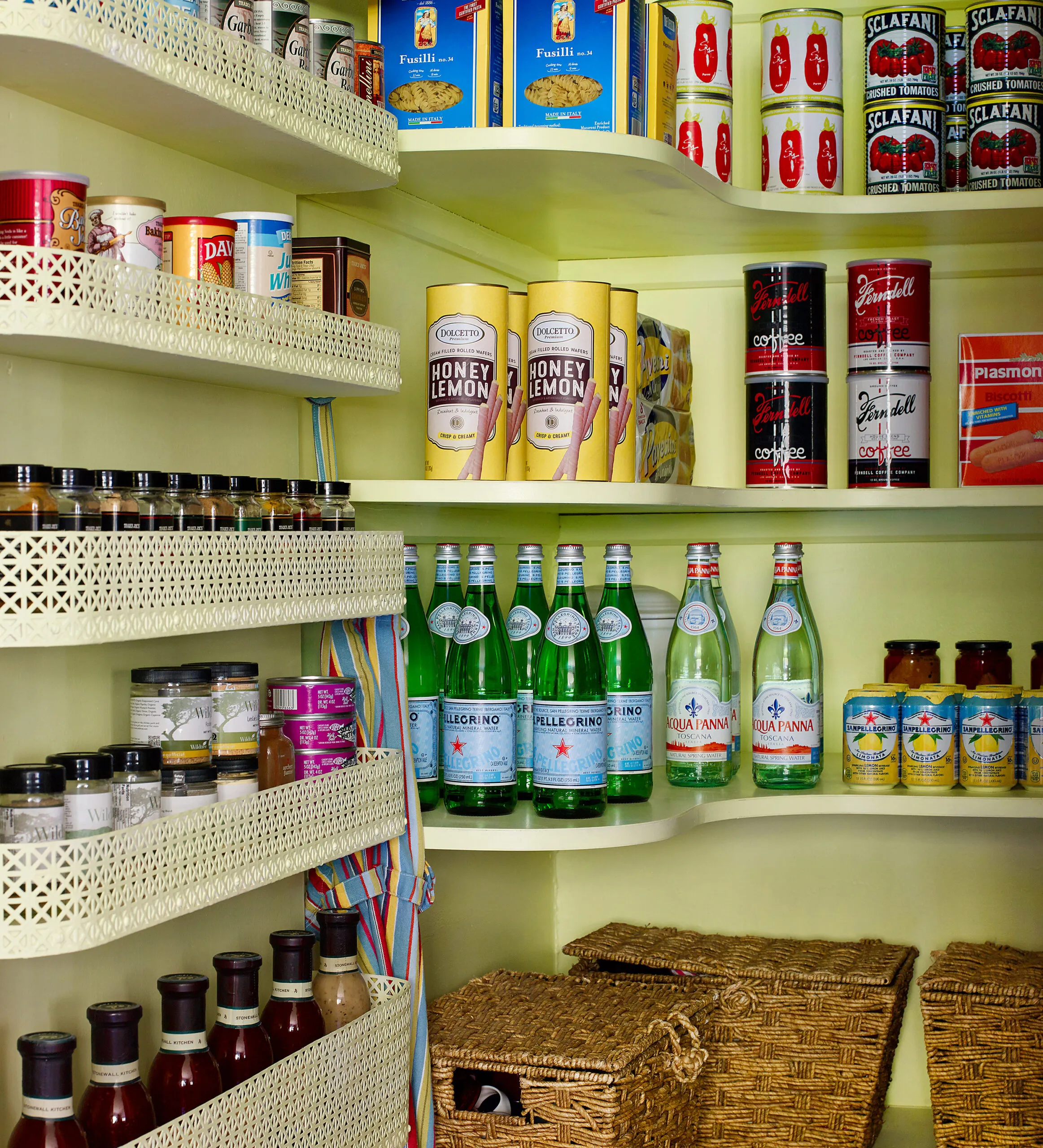
Rounded shelves eliminate sharp corners, and shallow ones for spices and condiments can be made with perforated aluminum.
Hang a Decorative Door
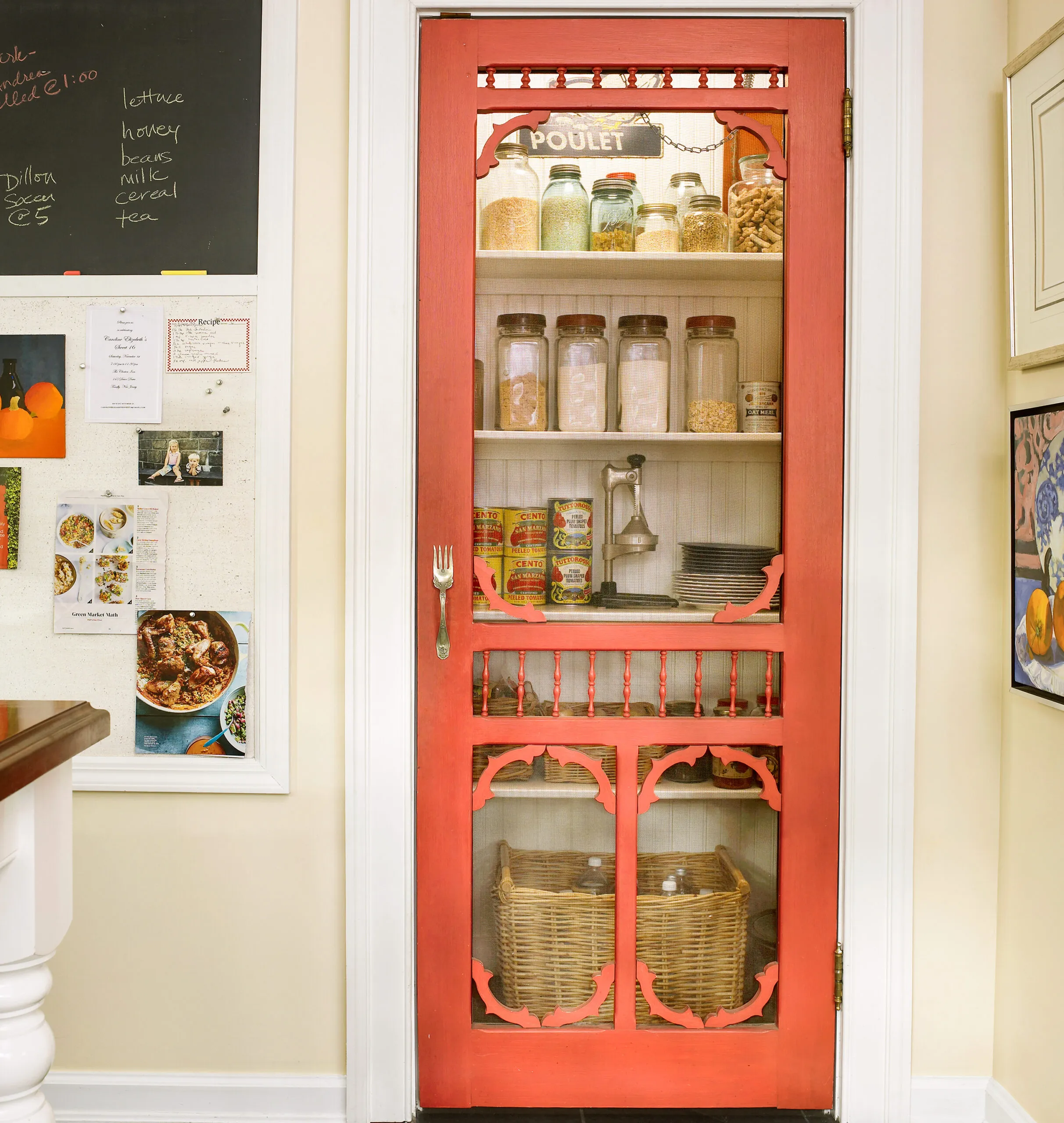
Help define the space while offering glimpses inside with a salvaged screen door or a high-quality reproduction like this beauty from Vintage Doors.
Trim It Out
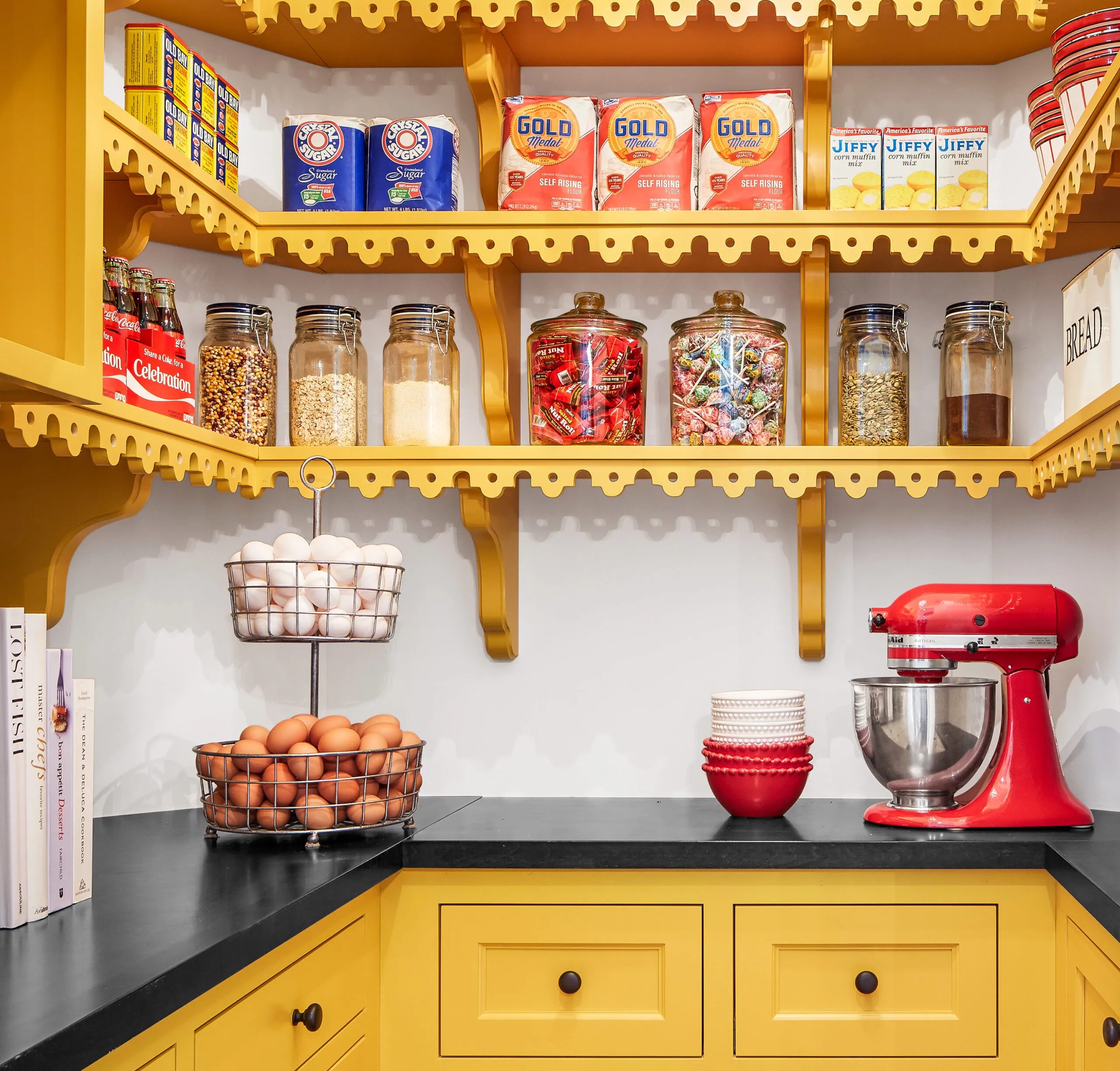
Design: Martha O’Hara Interiors
Evoke period lace shelf edging with easy-to-paint MDF Victorian Running Trim from Victorian Woodshop and add wood brackets from Vintage Woodworks.
Pantry Products We Love
Food Safety and Storage Tips for a Pantry
Store your goods in containers suited to their contents. Here are just a few of our team’s favorite storage ideas.
- Woven baskets with handles, like Crate & Barrel’s Sedona totes (from $25), are ideal for linens and come lidded or not.
- Rubbermaid Brilliance containers (from $14.99) are BPA-free, dishwasher-safe, and make rapid-turnover items like cereal and pasta easy to see.
- Stoneware canisters (from $65.95) feature tight-fitting, gasket-equipped lids to protect whole spices like cinnamon sticks and bay leaves from light and premature aging.
- Erasable food labels (from $9.99) allow you to label however you like. Use them to denote everything from contents to expiration dates.
What Not To Store in Your Pantry
Once you’ve designed the perfect pantry for your home, you must be mindful of what you’re storing in it. Some food items will have a shorter shelf life when stored in a pantry instead of a refrigerator or freezer, and some may cause a mess that could be difficult to clean up and possibly even ruin your pantry.
Here are some items that are better off staying away from your kitchen pantry:
- Chocolate: Believe it or not, refrigerated chocolate will taste much fresher than chocolate left in a pantry. If you don’t want it cold, take it out of the fridge a couple of hours before eating it.
- Cold-pressed oils: Oils such as sunflower oil and truffle oil will expire quickly if put in a pantry. To extend their shelf life, keep them in the fridge.
- Cured meats: Cured meats like salami will dry out quickly in a pantry. Put them in the fridge wrapped in butcher paper to preserve the shelf life.
- Fish sauce: Storing any fish sauce in your pantry could be a disaster in the making. Should it ever topple over and spill, the smell will linger for months, if not longer, no matter how you try to clean it out.
- Mustard: Mustard can ferment if kept in a cabinet, even before it’s opened, which could lead to a huge mess.
- Nuts: Nuts can go bad quickly, and storing them in the pantry could lead to them not being sealed properly in an airtight container, reducing their shelf life.
- Syrup: Storing maple syrup could cause it to go moldy outside of the fridge, and syrup that spilled is a huge hassle to clean.
Consider the Fridge or Freezer
It’s always a good idea to check an item’s shelf life—here are items to be particularly vigilant about:
- Olive oil is vulnerable to heat, light, oxygen, and time. Open it within six months, then store it in the fridge.
- Whole grains like brown rice, popcorn, oatmeal, and flour can get stale in months. Think about refrigerating or vacuum-packing them with a FoodSaver (from $164) or another high-quality vacuum sealer.
- Nuts can also turn rancid, as mentioned above—pine nuts after only one month, pecans after four. If you stock up, you should stash them in the freezer.
- Ground spices fade fast. Freezing can cause condensation, so we recommend storing your spices in the pantry and replacing them once or twice a year.
Our Conclusion
Pantries typically hold groceries and dry goods, but many homeowners squeeze in platters, small appliances, baskets to hold linens, paper goods, and cleaning supplies. Whatever you plan to store in your pantry, you can use this guide to consider all your options and create the pantry of your dreams.



